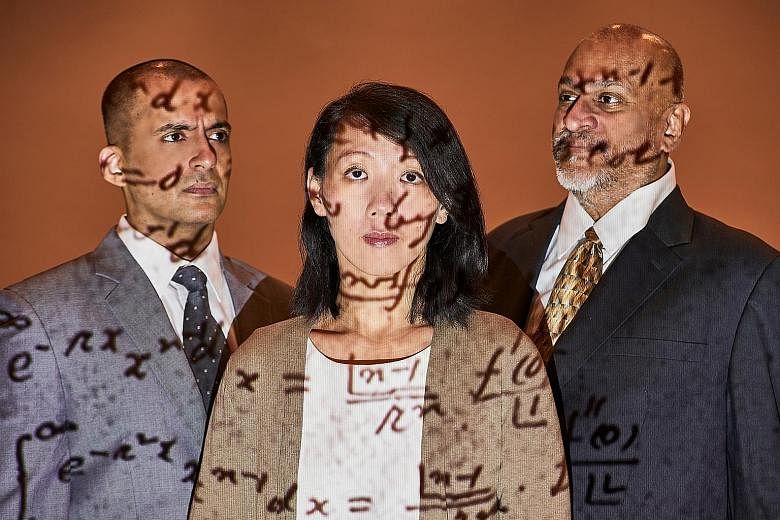Watching a professor scribble maths equations onto a whiteboard is not something you would usually expect to see in a theatre.
But one drama production at the National University of Singapore (NUS) will begin with several minutes of an actor doing just that - her lecture setting the stage for an intricately patterned story about love and the beauty of numbers.
A Disappearing Number, originally by British theatre group Complicite, will run for one night, on March 15, as part of NUS' upcoming maths-themed arts festival.
This Singapore staging of the acclaimed play is directed by theatre stalwart Edith Podesta.
"It's a love letter to mathematics through the language of love," says the 39-year-old. "The audience isn't just going to see dry maths. They are going to see a love affair, faith and friendship."
A Disappearing Number was conceived and originally directed by Complicite's founder Simon McBurney. It premiered at the Theatre Royal Plymouth in 2007 and won the Critics' Circle Theatre and Laurence Olivier awards for Best New Play.
It has two interwoven narratives.
-
BOOK IT / A DISAPPEARING NUMBER
WHERE: University Cultural Centre Hall, 50 Kent Ridge Crescent, National University of Singapore
WHEN: March 15, 8pm
ADMISSION: $25 & $15 (students)
INFO: For more information or to buy tickets, go to www.nus.edu.sg/cfa/NAF_2019/event-disappearing-number.html
The first is based on a true story. In 1913, the self-taught mathematician Srinivasa Ramanujan, a clerk in Chennai, sends Cambridge maths lecturer G.H. Hardy a letter filled with groundbreaking theorems.The two men develop an intellectual kinship, a collaboration Hardy regarded as the one romantic incident of his life.
Meanwhile, in the present, mathematics professor Ruth (Koh Wan Ching) and hedge fund manager Al (Pavan J. Singh) fall in love.
In the play, numerous voice-overs suggest how different times and places exist parallel to each other.
The Singapore production also features live tabla music by Nawaz Mirajkar and projections of handwritten equations - from Ramanujan's old letters and notebooks - that will be animated by multimedia artist Brian Gothong Tan.
A Disappearing Number is not just about love and maths, says Podesta. It is also about the Indian diaspora and faith.
"(Ramanujan) said that at night, he would pray... His goddess would put mathematics on the tip of his tongue and he would just write from there, which is why he had no (mathematical) proofs."
The NUS Arts Festival, from March 15 to 23, is in its 14th year. Past editions have explored topics such as quantum physics and dystopias.
In A Disappearing Number, professional actors Koh, Singh and Remesh Panicker - who plays a physicist called Aninda - will be joined by cast members from the university drama group NUS Stage.
To get their heads around lines as perplexing as "there are countable infinities and uncountable infinities", the director and cast sat down with NUS maths professor Chan Heng Huat for a three-hour lesson.
Prof Chan, Podesta adds, helped shed light on certain scenes, such as when Al asks Ruth if she wants children and she replies, cryptically: "One plus a half plus a quarter plus an eighth plus a sixteenth and so on, which in infinity sums to two."
Ramanujan died in 1920 aged 32. He may be long gone, but his maths is still used today and his genius is the subject of films such as The Man Who Knew Infinity (2015).
"The maths is real, but everything in our lives is transitory," Podesta adds. "For me, trying to understand that kind of genius is unfathomable - but I can understand his love, his passion, his creativity."


